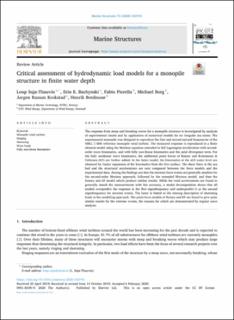| dc.contributor.author | Suja, Loup | |
| dc.contributor.author | Bachynski, Erin Elizabeth | |
| dc.contributor.author | Pierella, Fabio | |
| dc.contributor.author | Borg, Michael | |
| dc.contributor.author | Krokstad, Jørgen R | |
| dc.contributor.author | Bredmose, Henrik | |
| dc.date.accessioned | 2020-05-04T07:32:05Z | |
| dc.date.available | 2020-05-04T07:32:05Z | |
| dc.date.created | 2020-04-30T12:36:13Z | |
| dc.date.issued | 2020 | |
| dc.identifier.citation | Marine Structures. 2020, 72 (102743), | en_US |
| dc.identifier.issn | 0951-8339 | |
| dc.identifier.uri | https://hdl.handle.net/11250/2653124 | |
| dc.description.abstract | The response from steep and breaking waves for a monopile structure is investigated by analysis of experimental results and by application of numerical models for six irregular sea states. The experimental monopile was designed to reproduce the first and second natural frequencies of the NREL 5 MW reference monopile wind turbine. The measured response is reproduced in a finite element model using the Morison equation extended to full Lagrangian acceleration with second-order wave kinematics, and with fully non-linear kinematics and the axial divergence term. For the fully nonlinear wave kinematics, the additional point forces of Rainey and Kristiansen & Faltinsen (KF) are further added. In the latter model, the kinematics at the still water level are obtained by Taylor expansion of the kinematics from the free surface. The shear force at the sea bed and the structural accelerations are next compared between the force models and the experimental data. Among the findings are that the extreme force events are generally smallest for the second-order Morison approach, followed by the extended Morison model, and then the Rainey and KF model which produce similar results. While the total accelerations are found to generally match the measurements with fair accuracy, a modal decomposition shows that all models overpredict the response at the first eigenfrequency and underpredict it at the second eigenfrequency for extreme events. The latter is linked to the missing description of slamming loads in the modelling approach. The point force models of Rainey and KF are found to give quite similar results for the extreme events, the reasons for which are demonstrated by regular wave analysis. | en_US |
| dc.language.iso | eng | en_US |
| dc.publisher | Elsevier | en_US |
| dc.rights | Navngivelse 4.0 Internasjonal | * |
| dc.rights.uri | http://creativecommons.org/licenses/by/4.0/deed.no | * |
| dc.title | Critical assessment of hydrodynamic load models for a monopile structure in finite water depth | en_US |
| dc.type | Peer reviewed | en_US |
| dc.type | Journal article | en_US |
| dc.description.version | publishedVersion | en_US |
| dc.source.volume | 72 | en_US |
| dc.source.journal | Marine Structures | en_US |
| dc.identifier.doi | https://doi.org/10.1016/j.marstruc.2020.102743 | |
| dc.identifier.cristin | 1808844 | |
| dc.description.localcode | This is an open access article distributed under the terms of the Creative Commons CC-BY license, which permits unrestricted use, distribution, and reproduction in any medium, provided the original work is properly cited. | en_US |
| cristin.ispublished | true | |
| cristin.fulltext | original | |
| cristin.qualitycode | 2 | |

